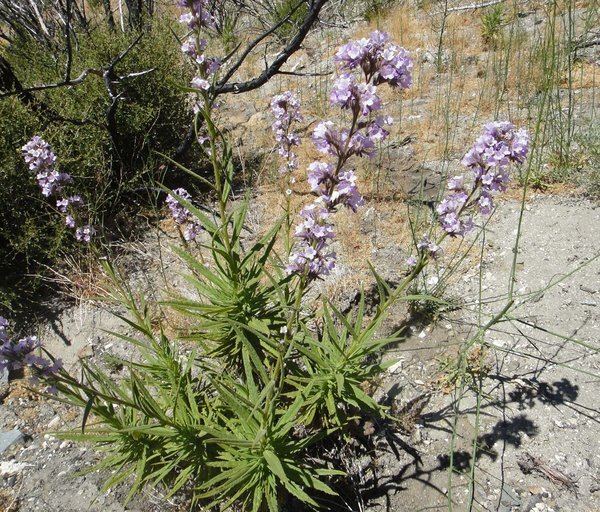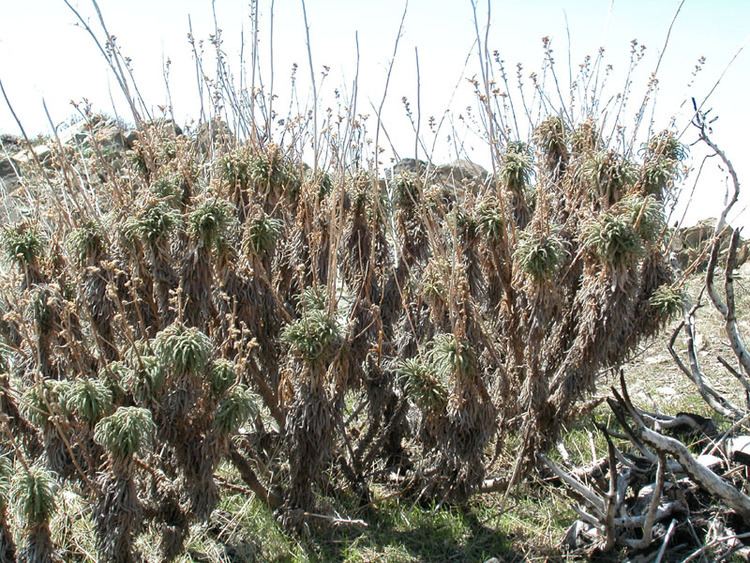Higher classification Turricula | Order (unplaced) Subfamily Hydrophylloideae Scientific name Turricula parryi Rank Species | |
 | ||
Similar Eriodictyon, Turricula, Eriodictyon trichocalyx, Wigandia, Eriodictyon crassifolium | ||
Pct video 22 5 25 14 eriodictyon parryi or poodle dog bush
Eriodictyon parryi or poodle-dog bush is a tall California mountain shrub with showy purple flowers, which is notable for secreting a severe skin irritant.
Contents
- Pct video 22 5 25 14 eriodictyon parryi or poodle dog bush
- Habitat
- Description
- Classification
- Skin irritant
- Scientific papers
- References

Habitat

The plant is endemic to southern California and Baja California. It is particularly common in the Transverse Ranges, and also occurs in the Coast Ranges south of San Luis Obispo, and in the Sierra Nevada as far north as Kings Canyon.

It is found in chaparral, on granitic slopes and ridges from 1,000 to 2,300 metres (3,300 to 7,500 ft). It thrives in areas of yellow pine forest that have been recently disturbed by fire or landslides, where it helps to prevent erosion and can cover burned hillsides with attractive color. The plant often remains dominant in such areas for about ten years until saplings and other plants fill back in and outcompete it. Its seeds can then remain dormant in soil for long periods, with the plant springing back up quickly at the next disturbance.

Presumably because of its irritant properties, poodle-dog bush is rarely grown in gardens despite its attractive flowers, and it is difficult to grow in garden conditions.
Description
It grows into a moderate size, perennial woody shrub, branching from the base but with main stems extending for up to 2 meters. Is leaves are long and narrow, and may be toothed at the edge; they can be from 4 to 30 centimetres (1.6 to 11.8 in) long. It flowers from June to August, having clusters (cymes) of attractive bell-shaped blue, lavender or purple flowers. However it has a rank smell. Its flower clusters and hairy stem are similar to those of many plants in the genus Phacelia, but it can be distinguished from them by its greater height.
Classification
When first described by Asa Gray, the poodle-dog bush was placed within the genus Nama. It was subsequently moved to a monotypic genus Turricula (having the same name as a genus of sea snails). Molecular phylogenetic analysis carried out by Ferguson (1998) supports treating Turricula as a separate genus within a clade (Ferguson does not use the term "subfamily") that includes Eriodictyon, and also the genera Nama and Wigandia. However, other molecular data support placing the plant in Eriodictyon.
Skin irritant
Like many species in the forget-me-not family, poodle-dog bush causes severe irritation if touched, akin to poison oak. It can raise blisters lasting as long as several weeks. There may be a delay of several days before the reaction starts. The hairs stick to skin and clothing. The allergic contact dermatitis is due to prenylated phenolics exuded by hairs (glandular trichomes) of the plant. The principal irritants are derivatives of farnesyl hydroquinone and 3-farnesyl-P-hydroxybenzoic acid. Once the immune system has been sensitized to the irritant, later exposure can cause a memory response, in which previously exposed areas erupt even though they were not exposed the second time.
Exposure can be prevented by learning to identify and avoid the plant, and by wearing gloves, long sleeves, and long pants. There is no definitive evidence on methods for cleansing contaminated skin of the hairs or the irritant they carry. It is not known whether washing with soap and water is effective, and there is better reason to believe that organic solvents such as acetone would be effective. If clothes are contaminated, they should not be washed along with uncontaminated clothing. It is possible that the irritant can be removed from clothing by soaking overnight in a solution of sodium carbonate, which can be prepared by heating baking soda in an oven for an hour at 100 °C (212 °F).
Topical anaesthetics should be chosen carefully because some types such as benzocaine may worsen the reaction; better drugs are lidocaine and pramoxine (brand names Sarna Sensitive and Itch-X). Oral or topical corticosteroids may be effective. Antihistamines are not effective, because the symptoms are not mediated by histamines.
Native Americans used the plant medicinally: Zigmond (1981, p. 68) reports that the Kawaiisu people used an infusion of the leaves to relieve swellings or rheumatism, and Sparkman (1908, p. 230) also reports that the Luiseño people (who knew it as Atovikut) used it medicinally, though he does not specify for what purpose. No clinical trials have been undertaken to support the efficacy of the plant for these clinical conditions, and there is no reliable evidence that it can be used for any type of treatment.
